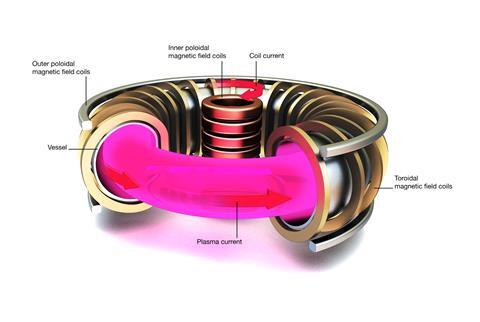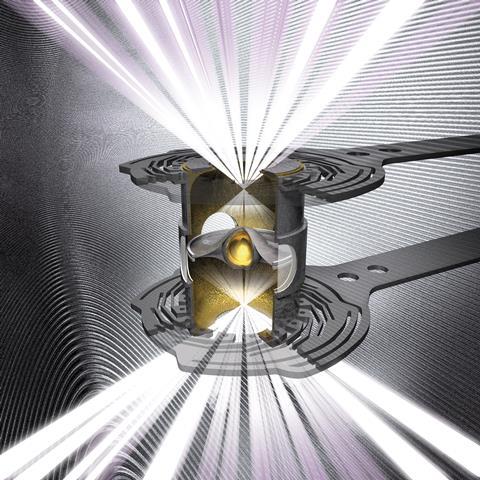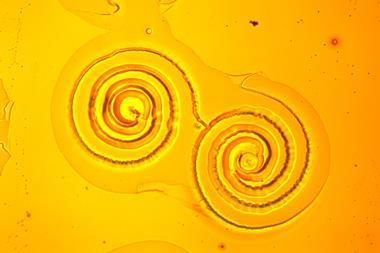Nuclear fusion has been a dream for decades. Kit Chapman finds out about the latest developments that could help it fulfil its promise
On 21 December 2021, a sleepy corner of Oxfordshire, UK, became ten times hotter than the core of the Sun. Inside the silvery, doughnut-shaped Joint European Torus (Jet), a fusion reaction produced from a glowing stream of plasma was sustained for five seconds. It only produced 59 megajoules of energy – barely enough to power a small home for a day – but everyone watching knew what the 11-megawatt burst meant. It was a new world record for energy produced by nuclear fusion.
Jet is based at the UK Atomic Energy Authority (UKAEA) at Culham Science Centre, the UK’s national laboratory for fusion research, and part of the wider Eurofusion collaboration of 28 European countries. Fernanda Rimini, Eurofusion’s senior exploitation manager at Jet, was one of the few to witness the event live. ‘I thought “I’m an adult, I’ve been there, I’ve done that, it’s not going to be exciting.” I was wrong. We were in this weird pandemic situation, there were only half a dozen people in the control room, we couldn’t have the whole team there… but we had the real-time measurement of neutrons. We’d scaled it so the top was 10 megawatts. And when it went off the scale, we knew. We went home and had a bottle of bubbly.’
For the uninitiated, producing such a low amount of energy in a facility that costs millions may seem like a waste of time. The idea of fusion power and its promise of near-limitless, clean energy has been around for a century, but a viable reactor still seems decades away. So why is fusion power worth getting excited about, and is it the future of energy, or merely a pipedream?
Fusion for beginners
Nuclear fusion is the combining of two atomic nuclei together to form a new, heavier nucleus. It’s how all of the elements heavier than hydrogen are formed, usually in the intense cosmic furnace of stars. Any nuclear fusion reaction that produces an atom lighter than iron-56 or nickel-62 is usually exothermic, resulting in the release of energy and neutrons. We see, and benefit, from the process every day: the Sun generates its energy through nuclear fusion, fusing around 500 million tonnes of hydrogen into helium every second. (Although this sounds impressive, the Sun is relatively inefficient as a nuclear reactor; it only achieves fusion in its core and relies on gravity, a comparatively weak force, to drive its reaction rates.)
Existing nuclear power relies on nuclear fission, the process of splitting atoms apart to produce lighter ones. To make power plants viable, they have to use heavy, radioactive elements such as uranium and plutonium. However, fission is less energy efficient than fusion, and produces higher quantities of radioactive waste. In contrast, fusion reactors could use any light element, but hydrogen, as the lightest and third most abundant element on Earth, makes the most sense, particularly in the form of its two heavier isotopes, deuterium and tritium. These contain one and two neutrons respectively, because they reach fusion conditions at lower temperatures than alternatives, and produce more energy than a ‘normal’ hydrogen atom. ‘What you produce is a helium particle, which remains in the plasma, heat in the plasma itself, and a neutron,’ Rimini says. ‘The energy you produce is more than what you put in. It takes very little to produce this energy, and you reuse the unspent fuel. It’s very, very efficient.’
You need high density and high temperatures to get the atoms close enough to collide and overcome repulsion
‘If we can make it work, it will be the ultimate energy source,’ explains Tammy Ma, a plasma physicist at Lawrence Livermore National Laboratory, US. ‘There are no carbon by-products, and we can obtain our fuel from, essentially, seawater. It’s plentiful, so there’s lots of benefits if we can make it work.’ The catch, she adds, is that nuclei are difficult to collide together for fusion to occur. And, as nuclei are positively charged because of their protons, they repel each other due to Coulomb repulsion. ‘You need high density and high temperatures to get the atoms bouncing around close enough together with enough energy to have enough probability to actually collide and overcome repulsion,’ Ma says, ‘And that’s why it’s so difficult.’
It’s this challenge – essentially how to replicate the interior of a star – that has led to very different angles to try and make fusion energy achievable. It’s a race that could decide how the world will be powered in the future.
Power vacuums
Jet is the spearhead of the European search for a viable fusion reactor. It centres on heating its deuterium and tritium to around 150 million degrees celsius, using magnetic fields to confine the plasma created. ‘It uses a tokamak,’ says Rimini, ‘which is a toroidal shape, a doughnut which is slightly elongated, and you inject some gas, which you ionise. This mix of ions and electrons means you can tie them to magnetic field lines, so if you produce the right magnetic field, the particle remains confined. Next, you need to heat them. We do that by injecting high-energy neutron particles – they have to be neutrons [neutrally charged] or they don’t go through the fields – and by radio waves at different frequencies. There are a lot of subtleties, but basically the wave will transfer, by resonance, some of its energy to the ions or electrons, and this will increase the temperature.’

A tokamak, then, is basically a circular cauldron, in a vacuum, for creating the conditions for fusion. Although it’s hard to reach the required temperatures, once done it’s highly efficient: during the December 2021 test, the team burned only around 0.1mg of tritium to produce the 59 megajoule record.
As mentioned, this is a relatively small amount of energy, and still only around 70% of that required to initiate the reaction, meaning it wouldn’t work as a power plant. Yet although it is the result of decades of research, Jet is only a stepping stone to the next European project, the International Thermonuclear Experimental Reactor (Iter), under construction in Provence, France. When it comes online in 2025, it will be the largest tokamak in the world, and hopes to produce an energy output 10 times greater than its start-up requirement. A follow-up class of tokamak, Demo, is already in the planning stages. Currently, Jet’s focus is to run experiments to help Iter’s design process, with the tokamak scheduled for decommissioning in 2023.
At Lawrence Livermore National Laboratory, Ma and the team takes a very different approach. ‘We use very energetic lasers,’ explains Ma. ‘We compress a fuel pellet that contains deuterium and tritium up to the very high densities and temperatures that make fusion possible – meeting a state where they can overcome Coulomb repulsion.’

Ma’s team does this at the lab’s National Ignition Facility (Nif). ‘Nif is the world’s largest, most energetic laser,’ she explains. ‘It’s 192 separate lasers, each one of which is close to the most energetic in the world. And it’s housed in a building that’s three American football fields wide and 10 storeys tall, which is needed for all the amplifying objects. In fact, it’s the world’s largest optical instrument.’ When it fires, the facility’s beams are amplified by 3070 sheets of phosphate glass doped with neodymium, each weighing 42kg and set at Brewster’s angle, which reduces reflective loss. ‘The idea is we take all of that energy, which comes to about 1.9 megajoules, and focus it down on a target the size of a small ball bearing, about 2mm in diameter.’
The target consists of a hohlraum, a small canister with two holes on either end to allow the lasers to come in. The lasers propagate through these laser entrance holes, hit the inside wall, and generate a very energetic bath of x-rays, which then compress the fuel pellet suspended in the centre of the hohlraum. ‘The x-ray energy ablates the outside surface of the capsule,’ Ma continues. ‘It flies off at a few hundred kilometres a second and, by conservation of momentum, the rest of the capsule has to drive inwards. That process heats and compresses the deuterium and tritium in the middle into fusion conditions.’ This shrinks the fuel in the pellet to around 100 times the density of lead, and heats it to 100 million degrees celsius. A single shot takes a few hundred picoseconds – roughly a million times faster than the blink of an eye – and operates at around 1000 times the power of the entire US electrical grid. Fortunately, the short time period means the team uses only about $14 (£11) worth of electricity per shot.

The team at Lawrence Livermore have also achieved huge milestones in the past year, obtaining a stage called ‘burning plasma’, where there is sustained, ongoing fusion reactions. ‘The idea behind fusion energy is that you want to produce more energy than you put in,’ says Ma. ‘Right now, we have demonstrated 70% ignition threshold – that was our big shot, last August. But for a power plant to work, the economics have to work out, too. You’d need to be gaining something in the order of 50–100 times more energy than you put in. So finding a target design, and an overall approach that can give you those high gains, is one of the big challenges for us right now.’
Material concerns
The greatest problem faced in fusion isn’t achieving the incredible temperatures required – it’s the materials science required to maintain that environment long-term. It’s why Jet couldn’t go past a few seconds, explains Rimini. ‘Jet is based on fairly old copper coils for the magnetic fields, and the tokamak walls are not actively water-cooled, so the high fusion period is only designed to run for 10–15 seconds at most.’
A reactor needs to be resistant to radiation, able to take extreme temperature and maintain its properties for its lifetime
UKAEA has built a new materials research facility at Culham Science Centre to tackle such problems. One of the staff searching for solutions is Greg Bailey, a computational nuclear physicist. ‘The copper magnets get too hot,’ he says. ‘So, in the future, we’re using superconducting magnets. And hopefully we’ll learn more.’ These material changes have already happened in the past. ‘Jet actually changed the material of its walls,’ Bailey says. ‘Initially we’d made the walls out of carbon, because that made life easier for the experiments. It should have been perfect, but, actually, it was terrible! We were getting a lot of tritium retention – we were losing our fuel into the wall, the hydrogen was drifting inside. So we had to change it.’
The design challenges discovered and solved by Jet are already being fed into Iter, explains Bailey. ‘What does a material for a reactor need to be? Resistant to damage [from radiation], it needs to be able to take the temperatures and extreme environments, and maintain its mechanical properties during its lifetime. So, in terms of a fusion reactor, the vast majority is probably going to be steel. The really interesting bits come inside the vacuum vessels, your housing, because they’re going to be facing extremes. They need armour, obviously.’
This has resulted in plans for Iter to be covered by 440 ‘blanket’ modules, weighing up to 4.6 tonnes, which cover the steel of the tokamak’s structure. Neutrons discharged during the reaction the enter the blanket can be slowed, and their kinetic energy transferred to a coolant system for another form of power. It’s hoped the blanket can also be used to solve another issue for reactors: their feedstock.
‘There’s plenty of deuterium on Earth,’ Bailey says, ‘but deuterium fusion produces much lower energy neutrons; it’s not really a viable source to make a power plant. And tritium is not naturally occurring.’ To obtain their tritium, the team plans to use lithium with an enhanced level of lithium-6, which can break apart under neutron irradiation to produce tritium. Although this is naturally occurring, the problem is that lithium is already in high demand for its use in lithium-ion batteries. ‘Frankly, when lithium comes into our reactor, we’re going to destroy it,’ Bailey says. ‘The fuel is not the problem; it’s how you produce it.’
This is where the blanket could come in, explains Bailey. ‘A lot of designs right now are mixing lithium with lead, or lithium with ceramic and some beryllium in there. The idea is that you get deuterium and tritium, the fusion reactor turns on, and neutrons produced in the fusion reactions smash into the blanket and tritium breeding reactions can occur. We can then extract that tritium to refuel the reactor. And, obviously, the neutron radiation into the blanket will cause a huge amount of heating.’ It’s still not perfected yet, but Bailey is confident the experiments done at Culham will show the way, potentially in collaboration with the private sector; fusion is already attracting major investors, including Amazon’s multibillionaire founder Jeff Bezos. ‘If we want to do fusion on an industrial scale we need to start building that supply chain now,’ says Rimini. ‘We need to start evolving the industry.’

At Lawrence Livermore, Ma’s team face different materials obstacles. ‘We need to develop supporting technologies,’ she says. ‘That includes lasers that are highly efficient and can run at a high repetition rate. At the Nif, we’re a scientific demonstration facility. For a power plant to work, we’d have to repeat the reaction about 10 times a second to get the maths to work out. And we need new materials that can withstand the high radiation fluxes and debris that we’re generating.’
This is one of the main challenges, Ma concedes. ‘Nevertheless, there are a lot of commonalities between the different fusion approaches,’ she says. ‘The materials issues, the tritium fuel cycle issues, the thermal conversion issues are all the same. We can make good progress in the next five to 10 years, if we have sufficient funding. But technologically, there’s no showstopper that we know of.’
No one in the fusion community, regardless of the technique used, is expecting these problems to be solved overnight. And, despite the promise of fusion now being a century old, the current challenges mean that the technology won’t be ready for decades. It won’t be a short-term solution to the rising costs of energy or reducing carbon emissions. ‘However,’ Ma adds, ‘we do believe that long term it has to be a component for net zero emissions for the world. And, once we figure it out, we could build a powerplant anywhere. It’s an energy source that will contribute to energy equity and benefit society on a large scale. That’s the benefit of fusion if we can make it.’
For now, then, fusion energy on a commercial scale remains a distant dream. And yet, given its potential, it’s a dream worth having.
Kit Chapman is a science journalist and lecturer at Falmouth University, UK.













2 readers' comments